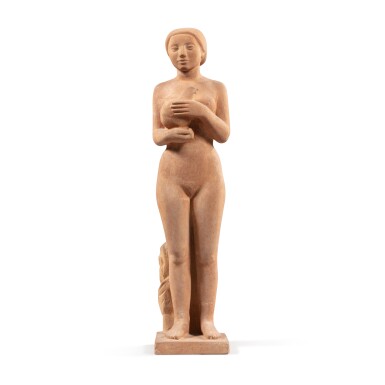Une Autre Modernité – Les arts figuratifs 1900–1950
Une Autre Modernité – Les arts figuratifs 1900–1950

Fernand Debonnaires
Woman holding a chicken | Femme tenant une poule
Lot Closed
March 22, 02:33 PM GMT
Estimate
2,000 - 3,000 EUR
Lot Details
Description
Fernand
1907 - 1997
Woman holding a chicken (1937)
terracotta
signed and dated Debonnaires / 1937
H. 83 cm; 32⅝ in.
____________________________________________
Fernand Debonnaires
1907 - 1997
Femme et oiseau (1937)
terre cuite
signé et daté Debonnaires / 1937
H. 83 cm ; 32⅝ in.
Fernand Debonnaires (1907-1997) left school at the age of 11 to regularly attend the Academy of Fine Arts of Brussels , then under the direction of Isidore de Rudder (1855-1943), Paul Du Bois (1859-1938), and Victor Rousseau (1865-1954). In 1928, he was awarded the Godecharle Prize, which enabled him to travel to France, Italy, and London. Due to his early success, Debonnaires’ works were acquired by both Belgian and foreign museums prior to 1930. He participated in the Brussels International Exposition of 1935 as well as the 1939 New York World’s Fair with large-scale works, an area of sculpture in which he excelled.
Debonnaires is inspired by the human body, which he translates into simple and sober shapes that border on geometrization. He embodies the generation of sculptors who, in the 1930s, were representative for a type of return to the classical ideal in contrast to the avant-gardes. However, this does not necessarily imply a reactionary attitude on the part of the sculptor. Having entered the history of Belgian art under the label of “Animism”, Debonnaires is firmly situated alongside George Grard (1901-1984), Oscar Jespers (1887-1970), Charles Leplae (1903-1961).
____________________________________________
Fernand Debonnaires (1907–1997) quitte l’école à 11 ans pour fréquenter régulièrement l’Académie des Beaux-Arts de Bruxelles sous la direction d’Isidore de Rudder (1855–1943), Paul Du Bois (1859–1938) et Victor Rousseau (1865–1954). En 1928, il obtient le Prix Godecharle, grâce auquel il voyage en France, en Italie et à Londres. Vu son succès précoce, les œuvres de Debonnaires sont acquises avant 1930 par des musées belges et étrangers. Il participera à l’Exposition universelle de 1935 à Bruxelles et de New York en 1939 avec des œuvres monumentales, art dans lequel il excelle.
Inspiré par le corps humain qu’il traduit en volumes simples et sobres, à la limite de la géométrisation, il incarne cette génération de sculpteurs qui, dans les années 30, représentent, en regard des avant-gardes, un certain retour à l’idéal classique qui n’implique pas nécessairement d’attitude réactionnaire. Entré dans l’histoire de l’art belge sous la bannière de l' « animisme », Debonnaires a sa place aux côtés de George Grard (1901–1984), Oscar Jespers (1887–1970), Charles Leplae (1903–1961).
